The first anti-tank gun Mauser T-Gewehr M1918
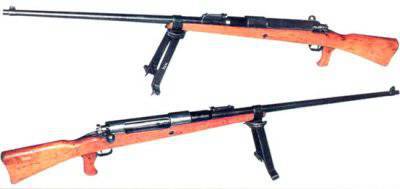 There is nothing surprising in the fact that the first anti-tank rifle was created in Germany, since it was in this country that the first to get to know tanks on a battlefield. Naturally, the tanks of the First World War had characteristics that were far from the highest, especially by modern standards, and many models of that time can now cause a smile. Nevertheless, it was a formidable weapon, both then and now, and it would be inappropriate to smile at the meeting with them. In view of the fact that tanks were becoming more widespread, it was urgently necessary to create a means of combating them, which would be easy to manufacture and maintain, efficient and at the same time cheap. Large-caliber machine guns were suitable for these purposes as well as possible, however, their weight did not allow to quickly change the position of the machine gun crew on the battlefield, because it required a more maneuverable means of fighting armored vehicles, and this was precisely what Mauser T-Gewehr M1918 anti-tank rifle became.
There is nothing surprising in the fact that the first anti-tank rifle was created in Germany, since it was in this country that the first to get to know tanks on a battlefield. Naturally, the tanks of the First World War had characteristics that were far from the highest, especially by modern standards, and many models of that time can now cause a smile. Nevertheless, it was a formidable weapon, both then and now, and it would be inappropriate to smile at the meeting with them. In view of the fact that tanks were becoming more widespread, it was urgently necessary to create a means of combating them, which would be easy to manufacture and maintain, efficient and at the same time cheap. Large-caliber machine guns were suitable for these purposes as well as possible, however, their weight did not allow to quickly change the position of the machine gun crew on the battlefield, because it required a more maneuverable means of fighting armored vehicles, and this was precisely what Mauser T-Gewehr M1918 anti-tank rifle became.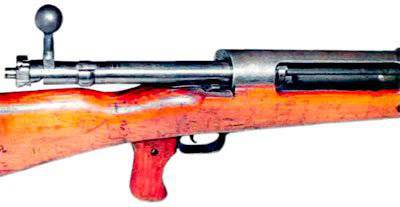 Unfortunately, nothing is known about whose idea it was to create the first anti-tank gun, since in November 1917, the weapon company Mauser received a specific task to adapt Mauser 98 to a more powerful cartridge 13х92, and already 21 of January of the next year the weapon was presented to the military as a complete sample. The weapon has retained the common features of the Mauser 98, however, it is not necessary to call models similar. The sample presented differed in quite a few moments from its progenitor. Naturally, first of all it was the size and weight of the weapon, but not only they. The basis of the weapon is a sliding bolt that locks the barrel when turning, but unlike the Mauser 98 shutter, the Mauser T-Gewehr M1918 anti-tank rifle had an 4 stop, on which the barrel bore was locked. Two of them were located in the front of the gate, and two more in the back. The weapon had no shop, that is, as a matter of fact, was single-shot. Submission of new ammunition was carried out through the window for ejection of spent cartridges. Despite the seeming simplicity of this simple manipulation of weapons, the practical rate of fire was just 6 shots per minute. There were no anti-tank guns that would have been able to extinguish recoil when firing, there was not even a back plate on the butt. Interestingly, the weapon had a separate pistol grip for convenient hold. In addition, the Mauser T-Gewehr M1918 anti-tank rifle also had bipods that were mounted in front of the forearm. Weapon sights consist of a pillar and a fly is designed for firing from 100 to 500 meters. In general, the PTR was quite a bit different from the progenitor, although, given the overall simplicity of the longitudinal slide weapon, it cannot be said that the weapon was fundamentally different from its smaller caliber prototype.
Unfortunately, nothing is known about whose idea it was to create the first anti-tank gun, since in November 1917, the weapon company Mauser received a specific task to adapt Mauser 98 to a more powerful cartridge 13х92, and already 21 of January of the next year the weapon was presented to the military as a complete sample. The weapon has retained the common features of the Mauser 98, however, it is not necessary to call models similar. The sample presented differed in quite a few moments from its progenitor. Naturally, first of all it was the size and weight of the weapon, but not only they. The basis of the weapon is a sliding bolt that locks the barrel when turning, but unlike the Mauser 98 shutter, the Mauser T-Gewehr M1918 anti-tank rifle had an 4 stop, on which the barrel bore was locked. Two of them were located in the front of the gate, and two more in the back. The weapon had no shop, that is, as a matter of fact, was single-shot. Submission of new ammunition was carried out through the window for ejection of spent cartridges. Despite the seeming simplicity of this simple manipulation of weapons, the practical rate of fire was just 6 shots per minute. There were no anti-tank guns that would have been able to extinguish recoil when firing, there was not even a back plate on the butt. Interestingly, the weapon had a separate pistol grip for convenient hold. In addition, the Mauser T-Gewehr M1918 anti-tank rifle also had bipods that were mounted in front of the forearm. Weapon sights consist of a pillar and a fly is designed for firing from 100 to 500 meters. In general, the PTR was quite a bit different from the progenitor, although, given the overall simplicity of the longitudinal slide weapon, it cannot be said that the weapon was fundamentally different from its smaller caliber prototype. 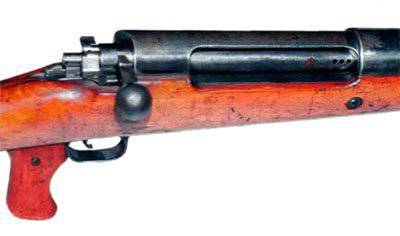 The weight of the weapon was 17,7 kilogram, while the length of the anti-tank gun was equal to 1680 millimeters. The length of the barrel PTR 984 millimeter. In general, it turned out quite serious in size and weight fool, although what is 17 a kilogram, when you want to live, especially since the calculation of the anti-tank gun included the 2 man, so that this weapon was moved around the battlefield quickly enough.
The weight of the weapon was 17,7 kilogram, while the length of the anti-tank gun was equal to 1680 millimeters. The length of the barrel PTR 984 millimeter. In general, it turned out quite serious in size and weight fool, although what is 17 a kilogram, when you want to live, especially since the calculation of the anti-tank gun included the 2 man, so that this weapon was moved around the battlefield quickly enough. The weapon without a cartridge is only iron, the combat qualities of which are zero, and the Mauser T-Gewehr M1918 anti-tank ammunition was interesting at that time. They commissioned the development of this cartridge is not Mauser, and Polte, and the company has completely coped with this task. True, the cartridge was developed not for the Mauser T-Gewehr M1918 anti-tank gun, but for the MG 18 heavy machine gun. Although it is usually said that the cartridge was developed taking into account the use of both the machine gun and the anti-tank gun, but I personally find it hard to believe that the Germans relied on two types of weapons at once, one of which has not yet shown itself. Therefore, I think it is more logical that the cartridge was developed specifically for the machine gun, and in the PTR it was already used as ammunition suitable for weapons. The metric designation of this ammunition 13x92, however, the more well-known name is T-Patron. The ammunition consisted of a bullet with an armor-piercing core, packed in a lead shirt and a bimetallic jacket, a brass sleeve with a groove and a protruding lip with a central combat cap, and a charge of nitrocellulose powder weighing 13 grams. The bullet cartridge had a weight 62,5 gram.
 A remarkable feature of this ammunition was that it was designed for a machine gun, and the most widespread in anti-tank rifles. The number of machine guns was limited to only fifty units, but the Germans managed to rivet a huge amount of PTR, namely 15800 guns, and this only until the end of 1918 of the year, that is, in less than a year. However, there is nothing surprising, since the Mauser T-Gewehr M1918 anti-tank rifle compared to the MG 18 machine gun can even be said to be primitive and very cheap.
A remarkable feature of this ammunition was that it was designed for a machine gun, and the most widespread in anti-tank rifles. The number of machine guns was limited to only fifty units, but the Germans managed to rivet a huge amount of PTR, namely 15800 guns, and this only until the end of 1918 of the year, that is, in less than a year. However, there is nothing surprising, since the Mauser T-Gewehr M1918 anti-tank rifle compared to the MG 18 machine gun can even be said to be primitive and very cheap. 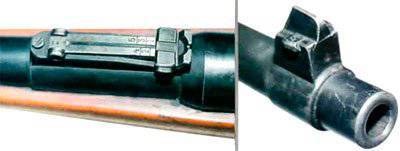 Of course, like any other weapon, the main issue when considering the Mauser T-Gewehr M1918 anti-gun is its effectiveness, that is, how well this weapon coped with its tasks. The armor penetration of this PTR was at that time more than satisfactory. So, at a distance of 100 meters, an anti-tank gun successfully pierced an armor sheet with a thickness of 26 millimeters. With an increase in the distance to the target to 200 meters, the thickness of the pierced armor was reduced to 23,5 millimeters. At a distance in 400 meters the weapon pierced the armor with a thickness of 21,5 millimeters, and on five hundred meters - 18 millimeters. It would seem that the indicators are more than good, but all of them are designed for the fact that the bullet hits at an angle of 90 degrees relative to the pierced armor plate, so not everything is as good as it may seem at first glance. However, for the tanks of the First World War this was more than enough, so there were no special claims to weapons.
Of course, like any other weapon, the main issue when considering the Mauser T-Gewehr M1918 anti-gun is its effectiveness, that is, how well this weapon coped with its tasks. The armor penetration of this PTR was at that time more than satisfactory. So, at a distance of 100 meters, an anti-tank gun successfully pierced an armor sheet with a thickness of 26 millimeters. With an increase in the distance to the target to 200 meters, the thickness of the pierced armor was reduced to 23,5 millimeters. At a distance in 400 meters the weapon pierced the armor with a thickness of 21,5 millimeters, and on five hundred meters - 18 millimeters. It would seem that the indicators are more than good, but all of them are designed for the fact that the bullet hits at an angle of 90 degrees relative to the pierced armor plate, so not everything is as good as it may seem at first glance. However, for the tanks of the First World War this was more than enough, so there were no special claims to weapons.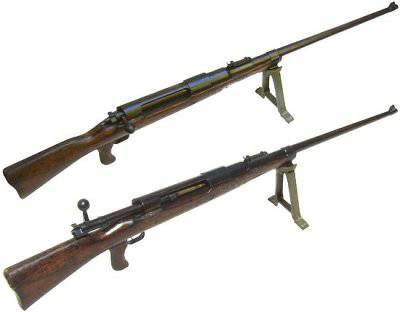 But the significant disadvantage was that the weapon was new in its own way, and the shooters often did not understand how to use it effectively. The fact is that the bullet of an anti-tank gun remains a simple bullet with high penetrability. Thus, in addition to having to get into the tank, which is not so difficult, it was necessary to get to certain places, which was much more difficult. The calculations of the Mauser T-Gewehr M1918 anti-tank guns should have been thoroughly aware of the design of their targets, and also be able to fire at anti-tank rifles with not the highest precision, so as to hit the main components, the places where the crew is located, and so on. Actually this was the main problem of the PTR. A vivid example is the situation when the tanks were a sieve, but their crew was alive and the technology itself was still functioning. Naturally, the anti-tank calculation was simply lost in the situation when more than ten shots were fired at the tank, and he still continued to move and fight. Thus, it was necessary to completely revise the approach to the training of calculations of anti-tank guns, spending many hours on training, most of which were devoted to the design of tanks, their weak points, and the crew's location in the car. As a result, it was possible to repeatedly increase the effectiveness of weapons, which once again proves that even the most perfect sample in useless hands is useless.
But the significant disadvantage was that the weapon was new in its own way, and the shooters often did not understand how to use it effectively. The fact is that the bullet of an anti-tank gun remains a simple bullet with high penetrability. Thus, in addition to having to get into the tank, which is not so difficult, it was necessary to get to certain places, which was much more difficult. The calculations of the Mauser T-Gewehr M1918 anti-tank guns should have been thoroughly aware of the design of their targets, and also be able to fire at anti-tank rifles with not the highest precision, so as to hit the main components, the places where the crew is located, and so on. Actually this was the main problem of the PTR. A vivid example is the situation when the tanks were a sieve, but their crew was alive and the technology itself was still functioning. Naturally, the anti-tank calculation was simply lost in the situation when more than ten shots were fired at the tank, and he still continued to move and fight. Thus, it was necessary to completely revise the approach to the training of calculations of anti-tank guns, spending many hours on training, most of which were devoted to the design of tanks, their weak points, and the crew's location in the car. As a result, it was possible to repeatedly increase the effectiveness of weapons, which once again proves that even the most perfect sample in useless hands is useless.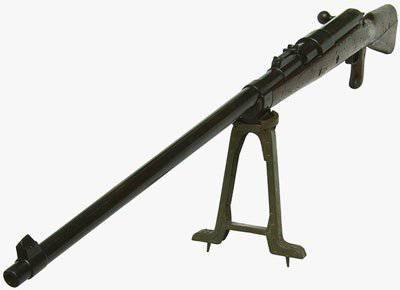 If we touch upon the question of the negative qualities of the Mauser T-Gewehr M1918 anti-tank gun itself, then there is a decent list. The main negative point was that the weapon had a very strong return. Naturally, they tried to fight this, but at the level of calculations of anti-tank guns, and not by the designers of gunsmiths. In the course for partial compensation of return when shooting were any available means. Most often, the butt of the weapon was wrapped with a cloth, which created a cushioning layer between the butt and the shooter’s shoulder, though there was little use for that. A more interesting option was to fasten a steel plate with a curved shoulder on the back of the butt. This plate increased the area of contact of the butt with the shooter’s shoulder; in addition, the plate itself was wrapped back with a thick layer of cloth. All these measures partially compensated for recoil when firing, but even so, and the decent weight of the recoil weapon was still on the verge of being transferred by humans. In general, the blue shoulder was a clear sign that a man fired a Mauser T-Gewehr M1918 anti-tank rifle. Also, a rather common occurrence was the change of shooters inside the calculation, so after making 3-5 shots, people changed each other, which had a positive effect on the effectiveness of the use of weapons. True, it is necessary to note here that that the change of the shooter was not always possible and sufficient, many people died at the very moment when one shooter replaced another, so it was not always possible to exchange money without risk.
If we touch upon the question of the negative qualities of the Mauser T-Gewehr M1918 anti-tank gun itself, then there is a decent list. The main negative point was that the weapon had a very strong return. Naturally, they tried to fight this, but at the level of calculations of anti-tank guns, and not by the designers of gunsmiths. In the course for partial compensation of return when shooting were any available means. Most often, the butt of the weapon was wrapped with a cloth, which created a cushioning layer between the butt and the shooter’s shoulder, though there was little use for that. A more interesting option was to fasten a steel plate with a curved shoulder on the back of the butt. This plate increased the area of contact of the butt with the shooter’s shoulder; in addition, the plate itself was wrapped back with a thick layer of cloth. All these measures partially compensated for recoil when firing, but even so, and the decent weight of the recoil weapon was still on the verge of being transferred by humans. In general, the blue shoulder was a clear sign that a man fired a Mauser T-Gewehr M1918 anti-tank rifle. Also, a rather common occurrence was the change of shooters inside the calculation, so after making 3-5 shots, people changed each other, which had a positive effect on the effectiveness of the use of weapons. True, it is necessary to note here that that the change of the shooter was not always possible and sufficient, many people died at the very moment when one shooter replaced another, so it was not always possible to exchange money without risk.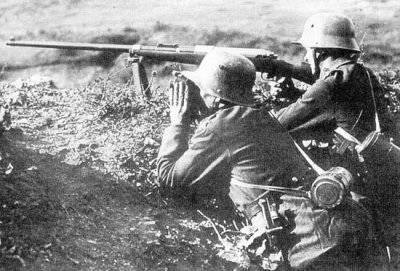 The second serious drawback of the weapon was that a lot of pressure in the barrel of the anti-tank gun led to very rapid barrel wear. This was especially noticeable with the first applications of PTR, when people, not knowing where to shoot, made too many ineffective shots and very quickly the resource of the barrels exhausted themselves. Well, and since the barrel in the weapon was in fact one of the most labor-intensive parts in the manufacture, we can say that it was necessary to re-do half of the anti-tank gun to reanimate the weapon. The best thing about this issue is the numbers. In total, it was planned to produce 30000 anti-tank guns Mauser T-Gewehr M1918, but only managed to make 15800, while by the end of 1918, less than a third, namely 4632 guns, were in working condition.
The second serious drawback of the weapon was that a lot of pressure in the barrel of the anti-tank gun led to very rapid barrel wear. This was especially noticeable with the first applications of PTR, when people, not knowing where to shoot, made too many ineffective shots and very quickly the resource of the barrels exhausted themselves. Well, and since the barrel in the weapon was in fact one of the most labor-intensive parts in the manufacture, we can say that it was necessary to re-do half of the anti-tank gun to reanimate the weapon. The best thing about this issue is the numbers. In total, it was planned to produce 30000 anti-tank guns Mauser T-Gewehr M1918, but only managed to make 15800, while by the end of 1918, less than a third, namely 4632 guns, were in working condition. Well, the third drawback of weapons was that the accuracy of the Mauser T-Gewehr M1918 anti-tank rifle left much to be desired, to talk about a confident hit on a tank at a distance of 500 meters, of course, you can safely, but it’s better to keep silent about this hit at this distance. Naturally, when the shooter knows that he can fire a tank at a distance of half a kilometer from his weapon, he tries and sticks to this distance so as not to approach the enemy’s formidable armored vehicles. Well, since not all people know such a word as “courage”, most calculations of anti-tank guns sought to keep the maximum possible distance, which, of course, also affected the effectiveness of the use of such weapons as the Mauser T-Gewehr M1918 anti-tank gun.
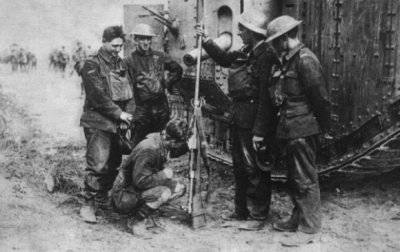 In general, despite all of the above disadvantages, the Mauser T-Gewehr M1918 anti-tank rifle has proven itself to be a fairly effective weapon in the fight against armored vehicles. Even taking into account the fact that its effectiveness was largely dependent on the skills and knowledge of calculating an anti-tank gun, in most cases on the battlefield this weapon coped well with its tasks, relatively quickly disabling armored vehicles and hitting the crew of the vehicle. Actually it is precisely because the idea of using anti-tank rifles in the fight against armored vehicles was further developed. And although most of the subsequent models of anti-tank guns were slightly different in their design and had all the same drawbacks as this first German anti-tank gun, some development can be observed not only in ammunition, but also in the weapon itself. Even if you take specifically the Mauser T-Gewehr M1918 anti-tank gun, they also tried to develop it into a more convenient sample. In particular, at the end of 1918, the company Mauser introduced a new version of the weapon, which was equipped with a detachable magazine, with a capacity of 5 cartridges, as well as an improved butt with a spring shock absorber. But this version of the PTR did not go to the series, and remained a prototype.
In general, despite all of the above disadvantages, the Mauser T-Gewehr M1918 anti-tank rifle has proven itself to be a fairly effective weapon in the fight against armored vehicles. Even taking into account the fact that its effectiveness was largely dependent on the skills and knowledge of calculating an anti-tank gun, in most cases on the battlefield this weapon coped well with its tasks, relatively quickly disabling armored vehicles and hitting the crew of the vehicle. Actually it is precisely because the idea of using anti-tank rifles in the fight against armored vehicles was further developed. And although most of the subsequent models of anti-tank guns were slightly different in their design and had all the same drawbacks as this first German anti-tank gun, some development can be observed not only in ammunition, but also in the weapon itself. Even if you take specifically the Mauser T-Gewehr M1918 anti-tank gun, they also tried to develop it into a more convenient sample. In particular, at the end of 1918, the company Mauser introduced a new version of the weapon, which was equipped with a detachable magazine, with a capacity of 5 cartridges, as well as an improved butt with a spring shock absorber. But this version of the PTR did not go to the series, and remained a prototype.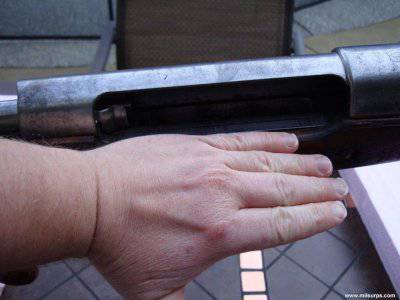 The fact that the Mauser T-Gewehr M1918 antitank rifle was a very good weapon for its time is also indicated by the fact that in the period between the two world wars, other countries actively used this weapon. The distribution in Germany of this gun was also quite wide during the war. It was originally planned to issue in the amount of one anti-tank rifle to the battalion, but by August 1918, the plans were revised and they began to staff each infantry company with a single unit of anti-tank rifles. After the end of the war, Germany was shackled by the Treaty of Versailles, under which it was forbidden to develop and produce weapons of new systems, which also included anti-tank guns. However, here it is possible to argue how much the system of this anti-tank gun can be called new. In general, despite the treaty, in 1932, Germany was armed with 1074 anti-tank guns Mauser T-Gewehr M1918. Actually it was the final weapon in Germany, because after 1932, the Mauser T-Gewehr M1918 was replaced by more advanced models of anti-tank rifles, although before World War II and at its initial stage, these guns were still used, though for training on firing on armored vehicles. On this life of weapons in Germany was over.
The fact that the Mauser T-Gewehr M1918 antitank rifle was a very good weapon for its time is also indicated by the fact that in the period between the two world wars, other countries actively used this weapon. The distribution in Germany of this gun was also quite wide during the war. It was originally planned to issue in the amount of one anti-tank rifle to the battalion, but by August 1918, the plans were revised and they began to staff each infantry company with a single unit of anti-tank rifles. After the end of the war, Germany was shackled by the Treaty of Versailles, under which it was forbidden to develop and produce weapons of new systems, which also included anti-tank guns. However, here it is possible to argue how much the system of this anti-tank gun can be called new. In general, despite the treaty, in 1932, Germany was armed with 1074 anti-tank guns Mauser T-Gewehr M1918. Actually it was the final weapon in Germany, because after 1932, the Mauser T-Gewehr M1918 was replaced by more advanced models of anti-tank rifles, although before World War II and at its initial stage, these guns were still used, though for training on firing on armored vehicles. On this life of weapons in Germany was over.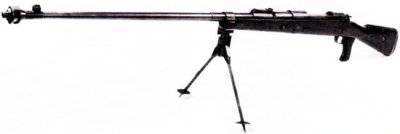 Despite the fact that in Germany the Mauser T-Gewehr M1918 anti-rifle was considered obsolete and was not used in combat, it does not mean that the anti-tank rifle was forgotten. In July, 1941, this sample was born again, this time in the territory of the Soviet Union. As you know, by the time of the German attack we did not have at our disposal designs of anti-tank guns, the mass production of which could be deployed quickly and at minimal cost. All that was proposed by the designers since 1936 either required revision, or it was very difficult to manufacture, moreover, one should not forget that the new samples were still untested. The Mauser T-Gewehr M1918 anti-tank rifle went through the war, proved itself well, and the most important thing in the production was easier than ever. After weighing all the pros and cons, it was decided to expand the production of the Mauser T-Gewehr M1918, but under the domestic cartridge and with some changes in the weapon itself. Do not think that the domestic designers simply "peredrali" German anti-tank gun, a lot of work was done before setting up the release of weapons. First of all, it should be noted that the anti-tank gun began to use the cartridge 12,7х108, which means that the PTR barrel was completely different, and the characteristics of the weapon itself were completely changed. A muzzle recoil brake-compensator was developed for the weapon, a shock-absorbing butt pad appeared on the butt, the sights were also changed. Rear sight received a graduation for firing on 200, 400 and 600 meters. Production of anti-tank guns was deployed on the basis of the Moscow Higher Technical School. Bauman, where several hundred of these anti-tank guns were created. Despite the fact that the time was hectic, the domestic versions of the Mauser T-Gewehr M1918 were much more accurate and more comfortable to use compared to the German ones. However, do not forget about the time gap in more than 20 years. With the advent of more sophisticated and effective PTDD and PTRS, the production of this anti-tank gun was curtailed and the Mauser T-Gewehr M1918 anti-tank gun was finally retired.
Despite the fact that in Germany the Mauser T-Gewehr M1918 anti-rifle was considered obsolete and was not used in combat, it does not mean that the anti-tank rifle was forgotten. In July, 1941, this sample was born again, this time in the territory of the Soviet Union. As you know, by the time of the German attack we did not have at our disposal designs of anti-tank guns, the mass production of which could be deployed quickly and at minimal cost. All that was proposed by the designers since 1936 either required revision, or it was very difficult to manufacture, moreover, one should not forget that the new samples were still untested. The Mauser T-Gewehr M1918 anti-tank rifle went through the war, proved itself well, and the most important thing in the production was easier than ever. After weighing all the pros and cons, it was decided to expand the production of the Mauser T-Gewehr M1918, but under the domestic cartridge and with some changes in the weapon itself. Do not think that the domestic designers simply "peredrali" German anti-tank gun, a lot of work was done before setting up the release of weapons. First of all, it should be noted that the anti-tank gun began to use the cartridge 12,7х108, which means that the PTR barrel was completely different, and the characteristics of the weapon itself were completely changed. A muzzle recoil brake-compensator was developed for the weapon, a shock-absorbing butt pad appeared on the butt, the sights were also changed. Rear sight received a graduation for firing on 200, 400 and 600 meters. Production of anti-tank guns was deployed on the basis of the Moscow Higher Technical School. Bauman, where several hundred of these anti-tank guns were created. Despite the fact that the time was hectic, the domestic versions of the Mauser T-Gewehr M1918 were much more accurate and more comfortable to use compared to the German ones. However, do not forget about the time gap in more than 20 years. With the advent of more sophisticated and effective PTDD and PTRS, the production of this anti-tank gun was curtailed and the Mauser T-Gewehr M1918 anti-tank gun was finally retired.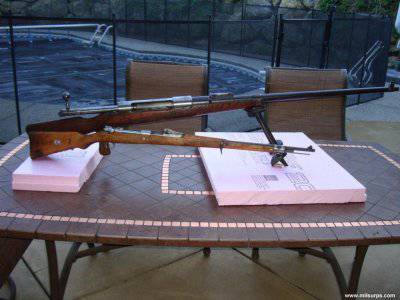 The Mauser T-Gewehr M1918 anti-tank rifle can be called the pioneer among anti-tank rifles. It is this weapon that showed that in capable hands, even a relatively small rifle can handle a tank. Despite the absurdity of the idea itself, the anti-tank gun repeatedly prevailed over armored vehicles. Of course, this weapon has its drawbacks, and in terms of efficiency even with a large-caliber machine gun it doesn’t compare, but such weapon advantages as mobility, simplicity and low cost of production make it an ideal option when it is necessary to defend, and money and time for more complex and effective no samples. Despite the fact that many people mark such weapons as completely ineffective, in my opinion, for its time, the anti-tank weapons system was an excellent means of fighting with armored vehicles, because the armored vehicles of the beginning of the war and its end were very different. If we take the negative qualities of weapons, then it seems to me that the main thing from them was not a big return, not ammunition, not weight and not dimensions. The main drawback of this weapon was that the anti-tank crew needed to know the design of the enemy’s tank, almost better than the crew of this tank, and the tank models, even at the initial stage of the war, were different, so learning how to calculate the anti-tank gun took too much time , as always, was not. As a result of little knowledge about the design of the enemy tank, the calculation could not use their weapons with maximum efficiency, however, the missing knowledge was obtained very quickly by experience, and if the entire experience of the fighters had been systematized and quickly transferred to the replenishment, then the effectiveness of the APP, , would have increased several times.
The Mauser T-Gewehr M1918 anti-tank rifle can be called the pioneer among anti-tank rifles. It is this weapon that showed that in capable hands, even a relatively small rifle can handle a tank. Despite the absurdity of the idea itself, the anti-tank gun repeatedly prevailed over armored vehicles. Of course, this weapon has its drawbacks, and in terms of efficiency even with a large-caliber machine gun it doesn’t compare, but such weapon advantages as mobility, simplicity and low cost of production make it an ideal option when it is necessary to defend, and money and time for more complex and effective no samples. Despite the fact that many people mark such weapons as completely ineffective, in my opinion, for its time, the anti-tank weapons system was an excellent means of fighting with armored vehicles, because the armored vehicles of the beginning of the war and its end were very different. If we take the negative qualities of weapons, then it seems to me that the main thing from them was not a big return, not ammunition, not weight and not dimensions. The main drawback of this weapon was that the anti-tank crew needed to know the design of the enemy’s tank, almost better than the crew of this tank, and the tank models, even at the initial stage of the war, were different, so learning how to calculate the anti-tank gun took too much time , as always, was not. As a result of little knowledge about the design of the enemy tank, the calculation could not use their weapons with maximum efficiency, however, the missing knowledge was obtained very quickly by experience, and if the entire experience of the fighters had been systematized and quickly transferred to the replenishment, then the effectiveness of the APP, , would have increased several times.
- Karasik Kirill
- weaponland.ru
- PTR Boys
The first anti-tank gun Mauser T-Gewehr M1918
Panzerbuchse 38 anti-tank rifle
Information